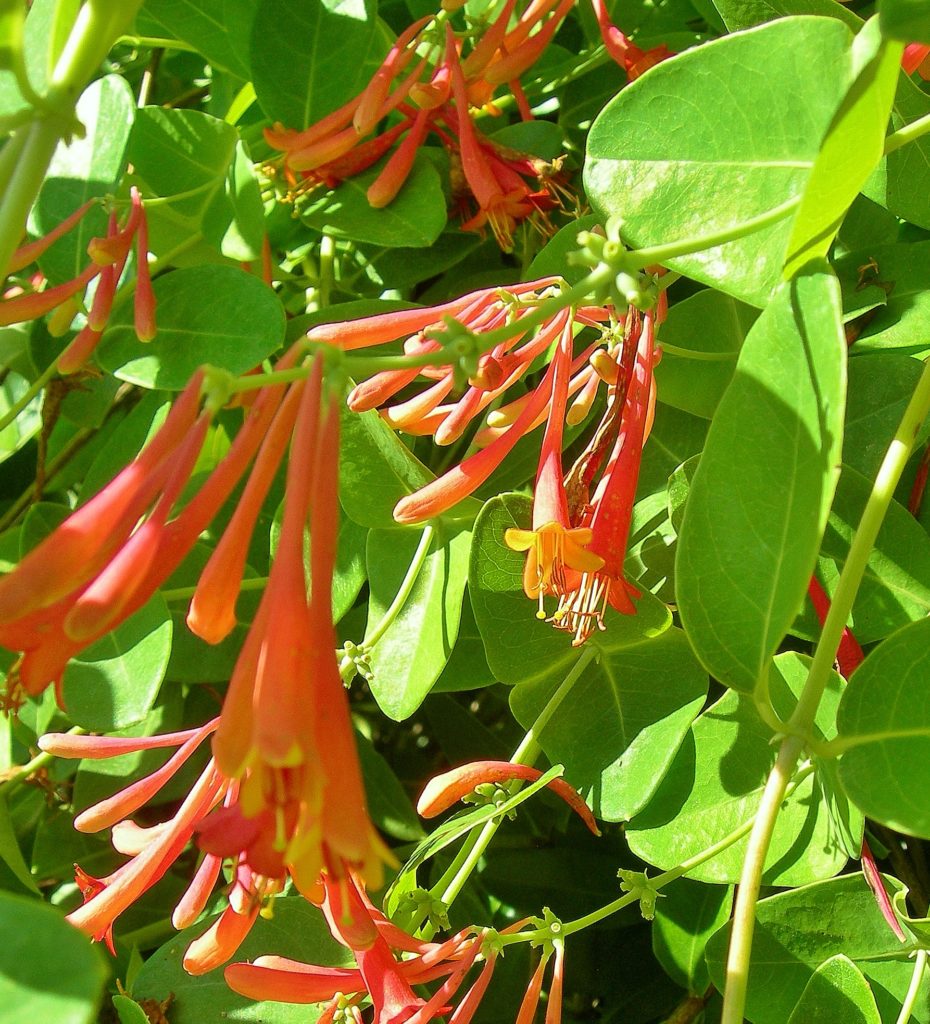Let’s talk about silent fireworks from the garden. It’s the season for sky booms which stress the four-legged denizen with who I share space. This is not a good thing as sky booms, thunderstorms, and fireworks, bring on lots of fears and a racing heart. I find a garden is a good place for an explosion of fireworks that don’t trigger anxieties and apprehensions.

Coral honeysuckle, Lonicera sempervirens, a native plant, provides all the dazzle needed to celebrate the holidays without the noise. This is a lovely native vining plant whose native habitat ranges from the northeastern U.S. west to Texas and south to Florida; it occurs in all lower 48 States. It is most abundant in the southeastern United States.
A twining vine, coral honeysuckle prefers to grow on things rather than along the ground, though it makes a fine groundcover. It has long stems, 8 to 15 feet, with papery, peeling bark, which are relatively well-behaved for a vine. The leaf shape is variable, linear when young, and oval without a stem when older. The leaves are evergreen in frost-free locations and opposite each other on the stem.
An explosion of tubular flowers occurs at the ends of the branches starting in spring and blooming throughout the summer. They are red on the outside and yellow on the inside and produce large amounts of nectar which attract hummingbirds and butterflies. Bright red fruits attract birds that consume them.
The right place to grow coral honeysuckle is just about anywhere with well-draining soils. The plant prefers non-acid locations with loose soil. After establishment, irrigation is only needed in the driest period. Full sun supports the best blooming, but the plants tolerate part to full shade. Unfortunately, they are not salt-tolerant. Freezing temperatures will knock the leaves off the vine or kill the plant to the ground, but it will regrow in the spring.
For best flowering, provide support for coral honeysuckle in the form of a trellis and support frames such as a gazebo, wire, or fence. A tidy vine, coral honeysuckle will twine around the supports and requires only moderate amounts of pruning to keep it under control.
Coral honeysuckle lights up the landscape like sparklers without the noise. Loud, booming noises can be hard on lots of folks and critters. Veterans, children, survivors of gun violence, anyone struggling with PTSD, pets, and wildlife are terrified by the booms. They all suffer and sometimes are further traumatized by the noise from fireworks. Enjoy the local commercial fireworks if you must celebrate with noise, or try some of the silent fireworks available at stores and kiosks that sell fireworks. Consider celebrating the day at home in the neighborhood with family, enjoying silent fireworks in the garden and the bright lights of fiery coral honeysuckle flowers. Let’s keep our communities quiet for our neighbors, friends, pets, wildlife, and family every year.
This column first appeared in the Treasure Coast Newspapers.
Leave a Reply